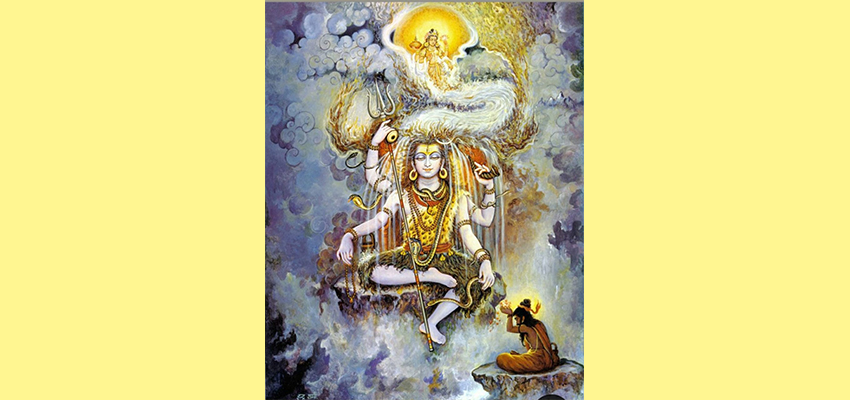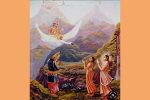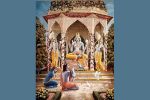NAME 18
Yogaḥ योगः
The One, who can be attained through Yoga. Yoga means union, the union of individual soul with the Supreme Soul. The one who consciously affirms that his soul is no way different from the Supreme Soul is a yogi. Such union can be accomplished by controlling one’s mind, as realisation of the Brahman takes place only in the mind.
When the mundane level of one’s consciousness transforms into the highest level of consciousness, also known as the Supreme Consciousness or the Purest form of Consciousness, the self realizes the Self. Till such time, a person continues to be deluded by illusion. The veil of delusion is removed instantaneously when the union between self and the Self takes place in the arena of one’s mind.
Kṛṣṇa explains this Bhagavad Gita (II.50), “Strive for the practice of yoga of equanimity (steadiness of mind)” to attain Me.
१८. ||ॐ योगाय नमः||
18. Om Yogaay Namah
Yogah -The one who is to be known or realized through yoga. By withdrawing the sense organs from their objects of preoccupation, when the mind of the seeker becomes quietened, he is lifted to a higher plane-of-consciousness, wherein he attains “yoga”, meaning wherein he realizes the Reality. At such moments of equanimity and mental quiet “yoga” is gained: Samatvam yoga uchyate- (Geeta Ch. 2, St. 48).
Since He is experienced through Yoga He is known as Yogah.
INTERPRETATION GUIDED BY SANT VANI (WORDS OF SAINTS)
Yogaḥ
The one to be attained through yoga.
One of the most popular words in the world, yet not fully understood. Generally, people associate the word ‘yoga’ with asanas which is an incomplete understanding of yoga. Asanas is only one of the 8 limbs of Ashtanga Yoga. Here, we understand the many meanings of yoga and what it meant by Viṣhṇu as Yoga. The root ‘yuj,’ from which the word yoga is derived, has two meanings,
‘yojana’ and ‘nirodha.’
‘Yojana’ is bringing together. What is separated either really or notionally is brought together and this is called union. Not knowing, that ‘I am the sought,’ one goes on seeing, and then there can be a separation between the seeker and the sought. This is a notional separation like that of the tenth man.
Ten people went on a picnic and on the way, they had to cross a river. After crossing the river, the leader counted to see if anyone was missing and found that there were only nine of them. He started to search for the tenth man, though he himself was the tenth man. Here there is a seeker-sought situation. The loss is notional and so, the seeker-sought union is possible only through knowledge and this is called yoga.
‘Yug’ also means ‘nirodha’, that is, discipline, control, mastery. What is not manageable, is made manageable. The legs are not manageable and they are made manageable, so that one can sit down. Yoga also implies diet, a healthy life with reference to the body, a life of values, dharma, yama, niyama, life of devotion to Īśvara, study of Vedānta and also understanding the holy
scriptures leading to the practices of Dhyana Dharana and Samadhi – the absolute union with the Higher Self. So, with the help of all these various disciplines, called yoga, the mind that is not manageable is made manageable. This is also yoga. That which resolves the differences between the seeker and sought is called yoga.
Tam vidyātduḥkha-saṁyoga-viyogaṁ yoga-sanjnitam–‘may one now, that the dissociation from the association with sorrow is what is called yoga’ (Bhagvat Gita 6.23). Here ‘yuj’ is used in the sense of ‘nirodha.’ Saṁyoga is association and viyoga is dissociation. So, the dissociation from the false association with sorrow is yoga. The sādhana is yoga and the sādhya is also yoga.
Yogenasādhyaḥ, avāpyaḥyogaḥ–the Lord is the one who is to be achieved by the various disciplines, so that one becomes together as a person. The Lord is the one, who is achieved by means of yoga and hence He is called Yoga.
Śankara quotes a sloka in his bhāṣya to show that the mastering of one’s mind along with the sense organs and the understanding of the oneness of the kṣetrajna and paramātmā is yoga, because, the jivaor the individual is essentially non-separate from Īśvara. Since He is to be gained by yoga, He is also known as yoga.
Four primary types of Yoga outlined by Patanjali Yog Sutras are Raja yog, Jnana Yog, Bhakti Yog and Karma yog.
Sri Krishna the Ultimate Yogi says
“In addition to asana (physical postures) and pranayama (breathing techniques), yoga according to the Bhagavad Gita is:
1. Clear, discerning, totally voluntary, dynamic participation in one’s life.
2. Everlasting, primal, revealing, the archetypal light and fueled by love.
3. Sacrifice that elevates us, motivates us, informs us, actively engages us and does so in a manner that is harmonious to all other living beings.
4. Selfless, cleansing, freeing, balancing, inspiring, and joyfully performed actions based on a vision in which one experiences peaceful interconnectedness with all life around them.
5. Nourished in the company of other yoga practitioners, by offerings of love, and the understandings they give rise to.
6. Heightened sensitivity and awareness of all life around us and within us, and an outpour of love in reciprocation with life’s wonder and beauty.
7. Fearless, illuminating, and a journey that does not end with death.
8. Vision that excludes nothing from its practice.
9. Intimate connection with the whole universe, with eternal realms even beyond the manifested universe, and with our own being’s endless capacity to love.
10. Pure, determined force that moves us toward the mysterious and secret, and connects us with the wonderfulness of existence, of being and of all life.”



